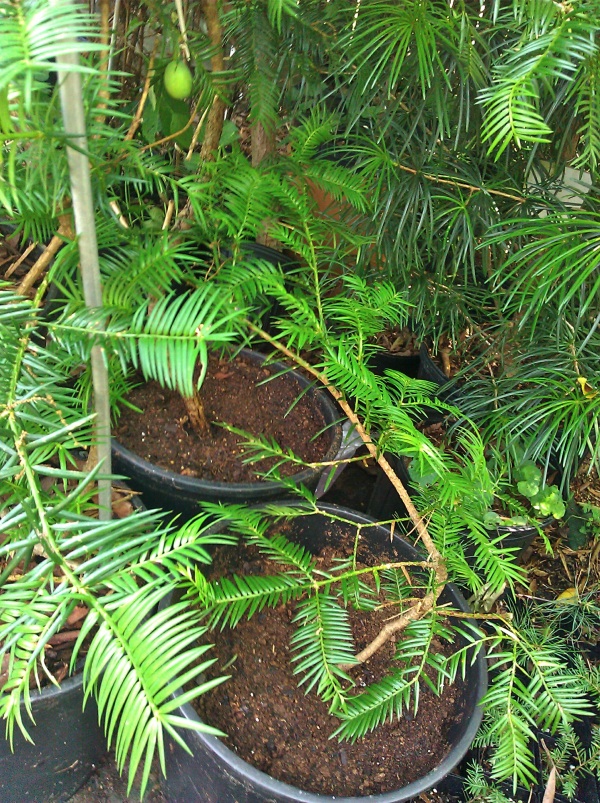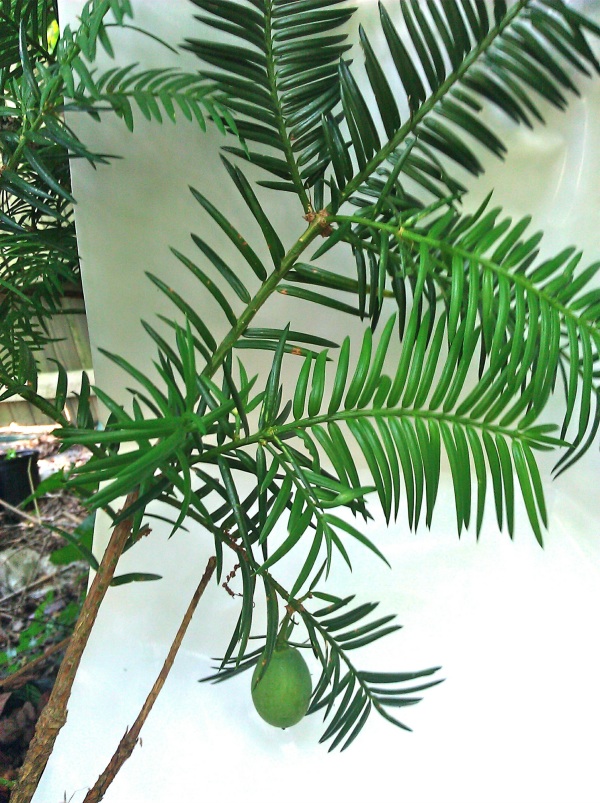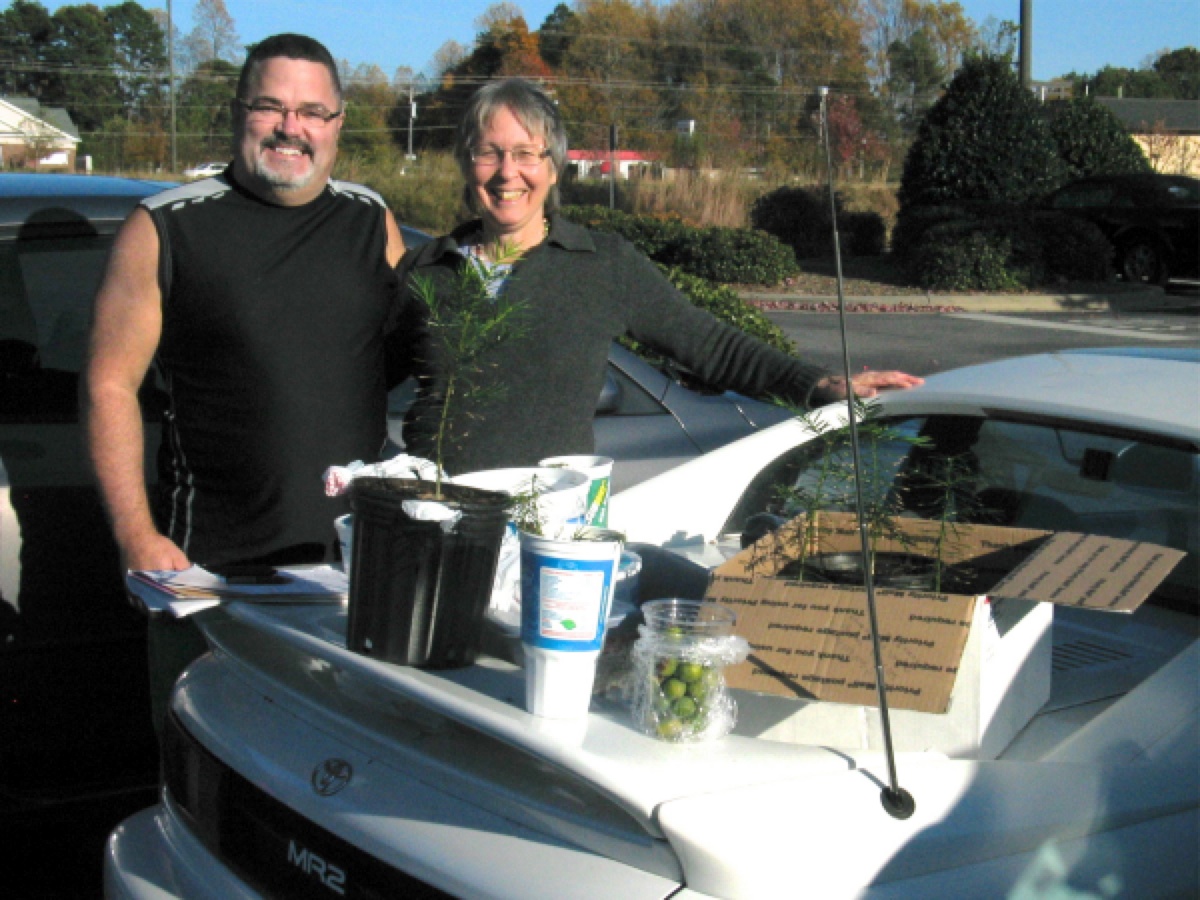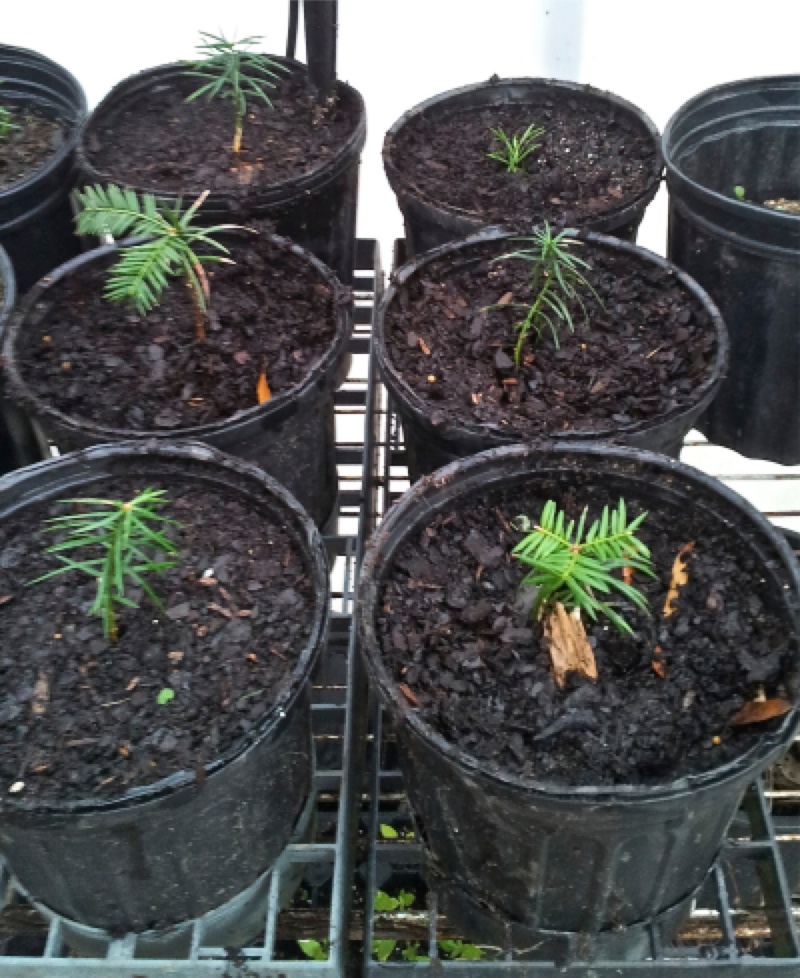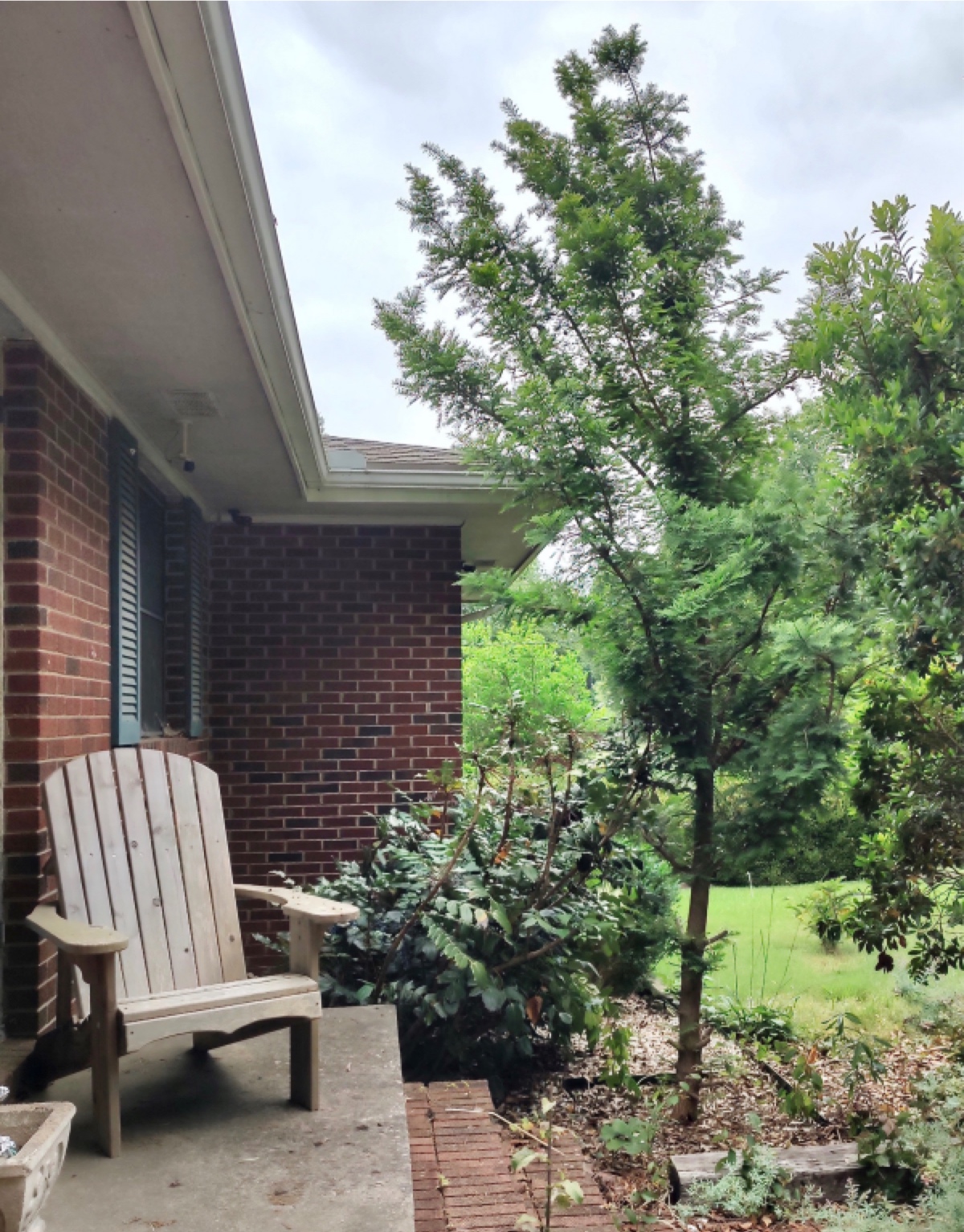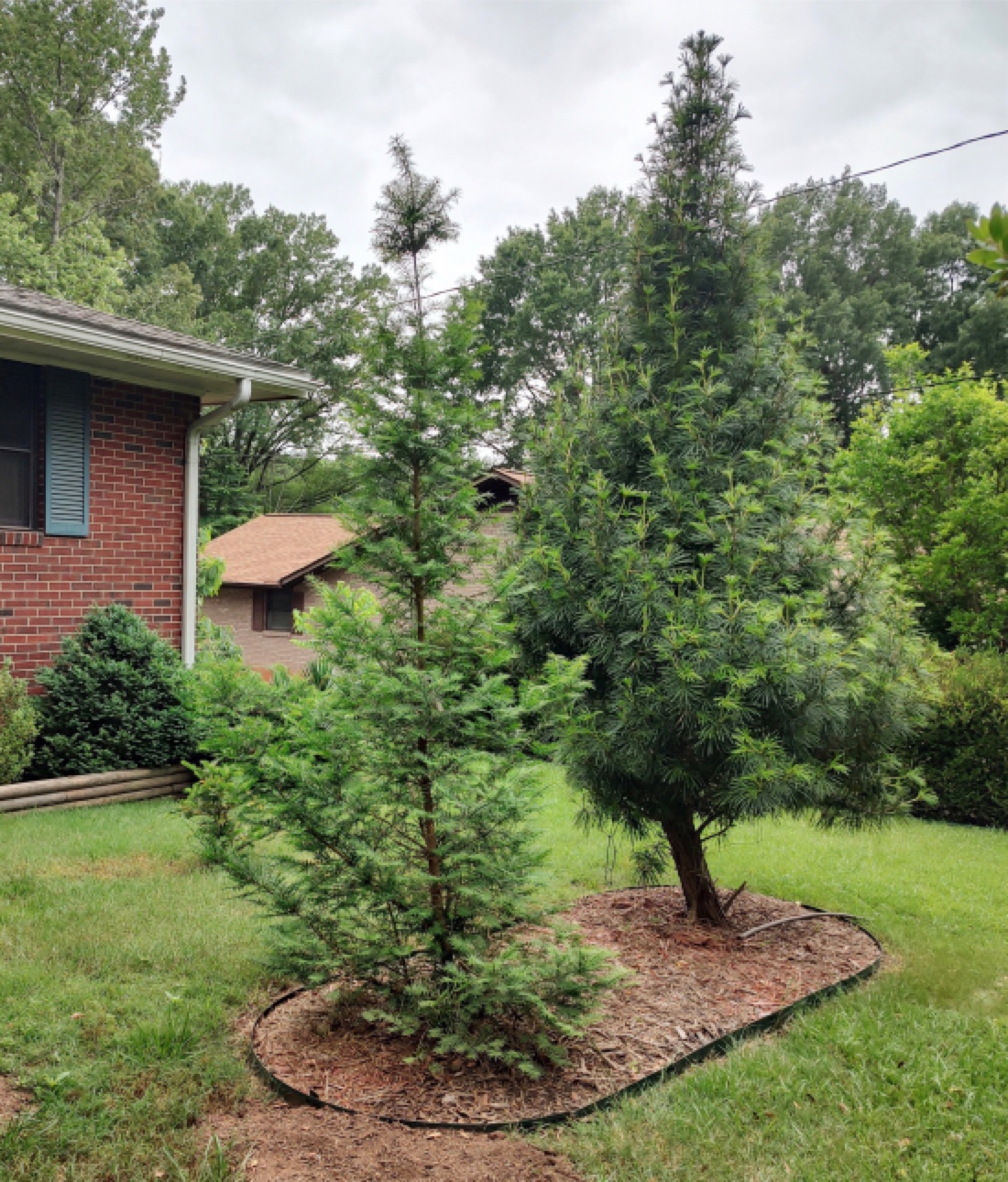
elevation approx. 700 feet
REPORT by Torreya Guardian volunteer, Jeff Morris Scroll down for photos and progress reports (from oldest to newest) --------------- 2005 INITIAL STATEMENT BY JEFF MORRIS: "The environment onto which I eventually plant the seedlings is Piedmont woodland, mostly hardwoods. It is a zone 7 climate, and the forest is semi-wild, having last been cut over in the 50s. Situated on a bluff overlooking the South Yadkin River, there are perhaps two areas I would consider microclimates, which might support zone 8 plantings. Shading would be from Spring through late October, as the forest is primary deciduous. Soil is low pH, mostly sandy clay, so I'll be liming the trees twice per year, to maximize protection from the blight that has decimated the native stands. The contour of the land is rolling hills and bluffs, so pretty much anywhere I choose will be well-drained. Knowing that T. taxifolia prefers mostly shade, I doubt that I would attempt to plant any of them in clearings." [EDITOR'S NOTE: This volunteer in Spencer, North Carolina, received 10 seeds from Torreya Guardians in autumn 2005, which were donated by Biltmore Estate from their Torreya taxifolia seed harvest in 2005. Following is Jeff Morris's report:]
JUNE 2011
I've not planted any in the "wild" as of yet. But I thought I would share with you something that might be of value. I have observed that the root structure of T. taxifolia is slow growing to the point that it would be very difficult for containerized seedlings to become root-bound. But once my 3 gallon container seedlings have a healthy root system, I began using gibberellic acid a/ka/a "GA3" (500 ppm max) as a foliant spray, on half my stock since 2009. The theory from other conifer enthusiasts was that this would assist in growth and maybe cause premature seed propagation. (Thus, it was essential for the root system to be very well-developed, since I would be asking it to pull alot more duty with the upper portion of the seedlings!) For the most part, the GA3 treated seedlings grew more foliage, and the girth and maturity of the 'trunk' is slightly greater.
But this morning, I discovered that on one of the purchased seedlings, I have 6 plums.
And on one of the seed-grown seedlings, I have a single plum. That's on a 4th year seedling, which thrilled me.
I misted GA3 on all remaining seedlings, which I intend to do on a weekly basis all this summer.
TAXUS FLORIDANA: I also had a purchased Taxus Floridiana sapling [FLORIDA YEW, also endangered from the same locale in northern Florida] that survived (the other one didn't make it), and it produced 7 seeded arils in 2009. After GA3 centrifugation and cold stratification for a year, I planted the yew seeds in a raised bed last fall. So far, 4 of them have germinated — possibly a 5th, but it is along a border with Prumnopitys andinus, making it difficult to distinguish. I had not used GA3 on the purchased Taxus Floridiana, but I intend to do so the rest of this summer on a weekly basis, to see if it causes more prolific (and frequent) seed production on that plant, also.
I am attaching some photos.
I will be making wire cages this afternoon, to place over all plums until they fully ripen and drop in late summer.
I also intend to use a GA3 centrifugation process for 24 hours prior to placing them in raised beds for the winter, which helps break internal dormancy in somewhat similar taxus, podocarpus, and prumnopitys species. As you might guess, I've set up an amateur laboratory for this purpose.
P.S. The Torreya taxifolias really appreciate LOTS of SHADE in my limited experience.
ABOVE: Two Torreya taxifolia seedlings germinated in 2007 from seeds harvested autumn 2005 at Biltmore Estate near Asheville NC (and donated by the Biltmore to Torreya Guardians)
ABOVE: The four seeds that germinated from the 2005 Biltmore harvest did so in 2007. One produced its first seed (while still in a pot) in 2011; it had been treated with GA3.
I have 7 seeds I'm about to harvest. I've built a germination box to place in the ground, with 1/4" rabbit wire to keep out rodents and squirrels. So far, my seedlings fit the containers, but probably in the Spring, it will be time to set at least three of them out. It's my intention to strike some cuttings from established females in January, and to graft some male branches onto female seedlings, to allow for more efficient seed production.
The environment onto which I would eventually plant the seedlings is "Piedmont woodland" mostly hardwoods. It is a zone 7 climate, and the forest is semi-wild, having last been cut over in the 50's. Situated on a bluff overlooking the South Yadkin River, there are perhaps two areas I would consider microclimates, which might support zone 8 plantings. Shading would be from Spring through late October, as the forest is primary deciduous. Soil is low pH, mostly sandy clay, so I'll be liming the trees twice per year, to maximize protection from the blight that has decimated the native stands. The contour of the land is rolling hills and bluffs, so pretty much anywhere I choose will be well-drained. Knowing that T. taxifolia prefers mostly shade, I doubt that I would attempt to plant any of them in clearings. I mainly want to go with what is tried and true, as opposed to experimentation, as my goal is to establish a seed source for this beautiful rare conifer.
Of the 4 seedlings that came from seeds, one female (out of what I believe to be 3 females) bore a single fruit, and based on your observations, I now believe that it was one of the purchased seedlings from Georgia that bore 6 fruits. I believe both other purchased seedlings are likely males. So the seedling that bore a single fruit is from the 2005 stock, and I'd guess the purchased seedlings were rooted in about 2003. I also have a Taxus floridiana that bore 5 seeds a couple years ago, and while it looks healthy, has not produced since then.
Received 40 seeds from 2011 seed distribution by Torreya Guardians.
Note of November 2013: The first of the 2011 seeds began sprouting in the spring of 2013; more have continued to sprout thereafter.
Report filed by Connie Barlow: On November 3, I met Torreya Guardian Jeff Morris for the first time. We met in a parking lot along I-40 north of Spencer. There we exchanged seeds/seedlings in order to promote genetic diversity within the orchards and plantings managed by Torreya Guardians.
ABOVE: Jeff Morris and Connie Barlow exchanging genetic diversity in November 2013, and the 6 seedlings from the Clinton tree, which Jeff transplanted into these pots and put into his greenhouse in Spencer NC.
ADDENDUM: A month after Connie collected the above seedlings and gave them to Jeff Morris to tend and propagate in North Carolina, Jeff made this crucial observation:
May 2023
ABOVE: The foreground tree in each photo is a Torreya taxifolia. The tallest (left) is 14 feet in height, and it bore fruit in 2022. The foreground tree in right photo is about 9 feet tall and is 4 or 5 years younger.
"From last year's seed harvest, I have 18 torreya seedlings which germinated in May out of a couple dozen harvested from my producing tree. The ones in the shaded greenhouse are thriving and very fast growing, already 6 inches with branches. This leads me to believe that Torreya taxifolia, in a manner similar to the PawPaw tree (Asimina triloba), is UV light intolerant to some degree during the first and possibly second season of growth. This could explain why they tend to grow on riverbanks and other partly shaded areas, but I'm not in a position to conduct more studious research on that theory."
Editor's note: Jeff scarifies torreya seeds, in a similar way to how he scarifies his home-grown Cephalotaxus seeds. (See the entry directly below.)
"I do scarify the Cephalotaxus seeds, using the Dremel sander attachment on my Dremel rotary tool. I scarify lightly along the seam in the seeds, on each side, so that when the seed swells, it takes very little resistance for it to separate the shell. Cold stratification for the winter, and optional socking for a day in GA-3, seems to assist with germination.
Editor's note: Cephalotaxus is a close relative to genus Torreya. Scroll up to June 2011 photos to see the leaf structure.
"I also save the fleshy 'hulls' to mix with sand and peat moss, then I roll up the seeds and soil mixture in bubble wrap, and set the roll in a pot, seeds planted about 3/4 inch below the soil mixture. Waiting a second season before planting does yield a few extra seedling, and they prefer at least the first season in a shade house, as opposed to even partial direct sunlight, until the seedling starts growing branches from the main trunk or leader. This is even more essential for T. taxifolia, as I've learned from practice. I believe there is some degree of UV resistance to direct sunlight the first season or two."
|


